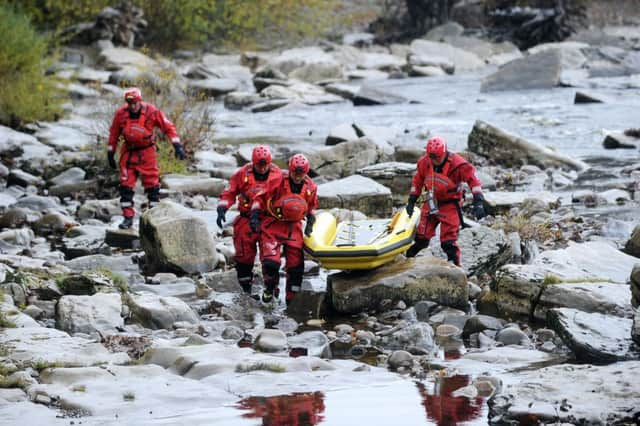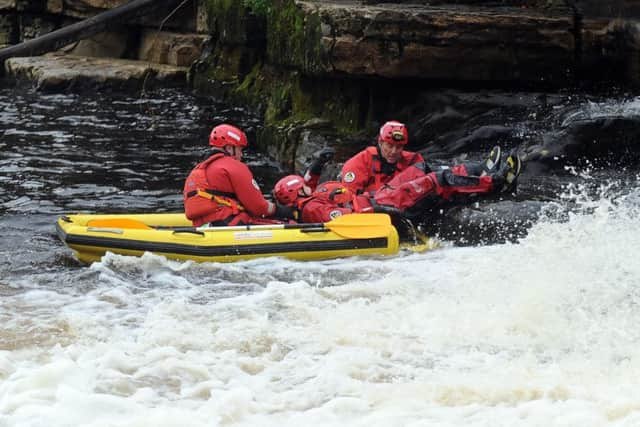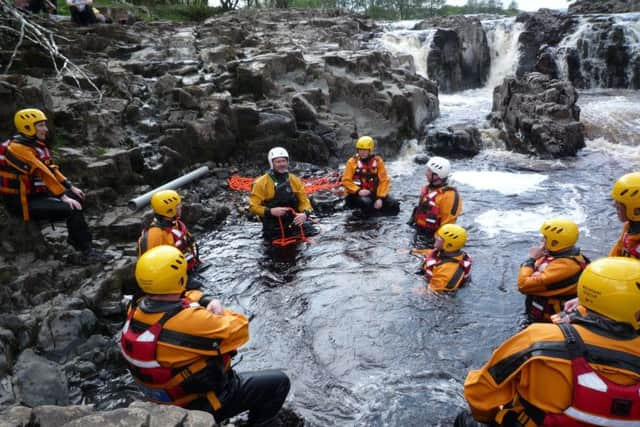The flood rescue team saving lives in the killer rivers of the Dales


In 2015, Storm Desmond’s heavy rain and flooding caused water to spill down Yorkshire’s most famous cliff for “the first time in living memory”.
The waterfall fell past the sooty black smudges on the bone-white limestone face of Malham Cove, said to be left by the young chimney sweep named Tom, hero of Charles Kingsley’s classic children’s book The Water Babies.
Advertisement
Hide AdAdvertisement
Hide AdIn addition, Yorkshire accommodates a waterway deemed one of the most dangerous in the world, namely the River Wharfe near Bolton Abbey. Here the Strid is a body of water so narrow it can be crossed with a leap, though woe betide those who fall in. They are almost inevitably drowned.


Accompanying the Wharfe (along with the Nidd) as they flow eastwards are England’s two swiftest rivers, the Swale and the Ure – racing neck and neck in a manner of speaking down steep gradients and over limestone benches.
An example is the main set of falls on Wensleydale’s Ure at Aysgarth: High, Middle and Low Falls.
The equally volatile Swale has been known to rise three metres in just 20 minutes.
Advertisement
Hide AdAdvertisement
Hide AdPeople blissfully unaware of the speed of the approaching water can easily find themselves in peril, because of a cloudburst further up the valley.


It is in these situations that the Swaledale Mountain Rescue Team is called into action. Its Swiftwater and Flood Rescue Unit (SWFRU) is one of three such specialist teams in the Yorkshire Dales, the others being the Cave Rescue Organisation (CRO) and the Upper Wharfedale Fell Rescue Association (UWFRA).
Based at Catterick Garrison, the Swaledale Mountain Rescue Team answers a wide variety of call-outs precipitated by spate water at its most dangerous in Swaledale, Wensleydale and beyond.
From responding to floods in places like Ripon, Boroughbridge or York, to battling racing currents from coast to coast, the swift-water technicians of the SWFRU rise to the challenge whenever they’re alerted by a group text message.
Advertisement
Hide AdAdvertisement
Hide AdIncidents can include people trapped in stalled cars as the water rises, not forgetting cattle and sheep struggling to keep their heads above fast-rising water.
In recent years call-outs for stricken kayakers have increased, though not usually when rivers are in full spate. It is when the level drops after the rain stops that their boats can “bottom out” with considerable force, bumping hard on the series of ledges in the riverbed – like at Kidson Force on the Swale near Keld.
During the Workington-Cockermouth-Keswick floods of 2009, the SWFRU helped rescue teams when a policeman directing traffic drowned as a bridge spanning the Derwent was swept away.
This presaged a collapse of Tadcaster’s 18th century Grade II-listed bridge in 2015 which – as happened in Workington – split the town in two.
Advertisement
Hide AdAdvertisement
Hide AdThe same year the SWFRU joined a number of other rescue teams helping evacuate people from their homes in Carlisle. When Storm Desmond brought about widespread chaos, police estimated between 2,200 and 3,500 homes were flooded after the River Eden burst its banks.
Closer to home, the Swaledale MRT’s swift-water technicians had a particular perplexing call-out that involved reports of blood on a rock in mid-river; a woolly headband lying nearby and a shivering terrier on another rock wet.
These were the only clues and there was no sign of the pet’s owner. All that was known was an 80-year-old woman had disappeared one cold November night near Gunnerside.
Rescue teams reasoned that the missing octogenarian must be on the far side of the fast-speeding current, highly unlikely as it seemed – and so she was.
Advertisement
Hide AdAdvertisement
Hide AdThe dog had fallen down a steep embankment; its owner had gone to the rescue and slipped. She had hit her head on the rock, landed stunned in the water yet still managed to swim to the far side in the dark where she was found in a hypothermic state. She recovered in hospital after her ordeal.
“Swale is the old Norse word for ‘swift’,” says MRT member Dr William Lumb. This is especially the case after serious thunderstorms have bucketed down in upper Swaledale. Then the Swale’s water-level rises so quickly that people miles downstream are oblivious to the advancing threat – as befits England’s fastest rising river.
“Children delight in playing on the rocks in mid stream above Richmond Falls when the water level is low. Yet a cloudburst over Muker a few miles upriver heralds danger,” says Dr Lumb.
“As the spate water finally reaches them, they may not notice at first that the water is effectively cutting off their picnic site. But within an hour, out of the blue, the river will threaten to sweep them over the brink of the falls.”
Advertisement
Hide AdAdvertisement
Hide AdDr Lumb is a GP in Sedbergh, as well as being a big man who comes into his own when helping to hoist a stretcher up a river bank or haul on ropes above a weir.
He points out that he is no longer a swift-water technician as he doesn’t have the time to attend the refresher courses needed by members of this important and prestigious unit.
SWFRU rescue controller Steve Clough takes over the thread of our conversation. “Of these many instances where the team has gone to the rescue, most were successful, saving life in widely differing circumstances,” he points out.
“Remember, there are three things about swift water that never change. It is powerful, it is relentless, but it is also predictable. Knowing this, it is usually possible to rescue someone without even getting wet.
Advertisement
Hide AdAdvertisement
Hide Ad“We never go into the water unless as a final resort, and without knowing exactly what to do in advance.”
As Clough explains the best options need to be quickly assessed. “Things to try first are: talk to them; reach out with a ladder, pole, tree branch, or something similar; throw a line and/or something buoyant like a lifebelt; wade, if possible; or tow them to safety,” he says.
“Failing these being the answer, only then do we consider entering the river. We certainly do not dive in regardless.”
He shudders at the thought, reiterating Dr Lumb’s advice that “everyone wants a hero… or to be a hero, or heroine”.
Advertisement
Hide AdAdvertisement
Hide AdHence the need to suppress the urge “to do something radical” when someone sees a person struggling in swift water.
“The pressure to be seen to be doing something brave has been responsible for too many drownings,” says Steve.
One occasion when team members did enter water was during the 2015 floods in Carlisle. Dozens of families, many with young children and pets, had to be evacuated from their homes through the night.
“Floodwater was halfway up the stairs. Although it looked safe enough, it was only after a careful risk assessment that we donned dry suits and entered the water,” says Steve.
Advertisement
Hide AdAdvertisement
Hide AdAs he points out: “Risk is fine so long as it can be controlled.”
It is the creed of the SWFRU. More power to the combined elbows of this courageous team that has no thought but for others in distress.